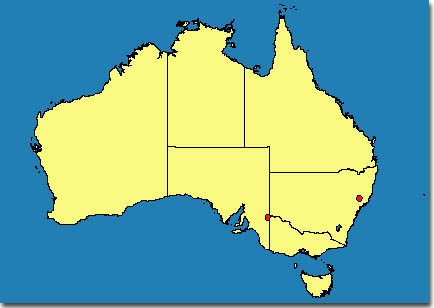

 |
 |
||
|
|
|||
| Diagnosis | Encarsia accenta Schmidt & Naumann |
|||||||||||||
| Species group | ||||||||||||||
| Distribution | ||||||||||||||
| Host | ||||||||||||||
| Comments | ||||||||||||||
| Illustrations | ||||||||||||||
| DNA | ||||||||||||||
Encarsia accenta Schmidt & Naumann, 2001. Holotype female, South Australia, Renmark, 4.i.1997 (P. De Barro) ex Bemisia sp. on Atriplex rhagodioides (ANIC). |
||||||||||||||
Diagnosis |
FemaleColourHead yellow, with dark transverse band between eyes in frontal view, sometimes head largely brown with vertex and lower head lighter. Mesosoma light brown, scutellum lighter and propodeum darker than rest of mesosoma. Petiole brown. Gaster largely yellow yellow to white, at base with sharply defined narrow dark brown band, fifth tergite laterally and sixth tergite with complete narrow dark brown band anteriorly. Antenna yellow with scape, pedicel and apical segments darkened. Fore wing hyaline. Legs yellow. MorphologyClava 2-segmented. Pedicel longer than F1 (1.26-1.30). F1 2.16-2.5 x as long as wide, slightly shorter than F2 (0.83-0.93) and F3 (0.82-0.88). Flagellomers with the following numbers of sensilla: F1: 0, F2: 1, F3: 2, F4: 3, F5: 3, F6: 3. Interocellar triangle with rugose-reticulate surface sculpture. Mid lobe of mesoscutum with 8 setae arranged symmetrically, side lobes with 3 setae each. Mesoscutal midlobe, axillae, and scutellum with rather fine but distinctive reticulation, cells with distinct internal striations. Scutellar sensilla widely separated, approximately 7 x the width of a sensillum. Distance between anterior pair of scutellar setae larger than between posterior pair. Fore wing 2.4 x as long as wide. Marginal fringe 0.26-0.29 x as long as wing width. Submarginal vein with 2 setae, marginal vein anteriorly with 7-9 setae. Tarsus of middle leg 5-segmented. Apical spur of midtibia distinctly shorter than half the length of the corresponding basitarsus (0.27-0.36). Tergites laterally with the following number of setae: T2: 2, T3: 2, T4: 2, T5: 2, T6: 3, T7: 3. T8 with 4 setae. Ovipositor subequal in length to middle tibia (0.99-1.04). Third valvula 0.32-0.34 x as long as the second valvifer. MaleOverall colour of mesosoma brown. Mesoscutal midlobe, side lobes, and scutellum lighter. Metasoma predominantly brown. Legs yellow except coxae brown and hind femur slightly darkened. Antennae yellow with pedicel darkened. Head predominantly brown, top of head lighter. Apical two segments of flagellum fused and sensilla partly overlapping. |
|||||||||||||
Species
|
Encarsia inaron-group |
|||||||||||||
Distribution |
 Click here for material examined window. |
|||||||||||||
Host |
An unidentified species of the B. tabaci complex. |
|||||||||||||
Comments |
This species belongs together with E. adusta Schmidt & Naumann and E. azimi Hayat to the E. inaron species group. Encarsia accenta is characterised by the distinctive colour pattern of the gaster. For differentiating E. accenta from the following two species see comments under E. adusta. |
|||||||||||||
Illustrations |
|
|||||||||||||
DNA
|
28S-D2 rDNA: GenBank Accession Code:AF254228. |
|||||||||||||
| © Copyright 2001, CSIRO Australia |
| [webmaster - February 2001] |
| Use of this web site and information available from it is subject to our |
| Legal Notice and Disclaimer |